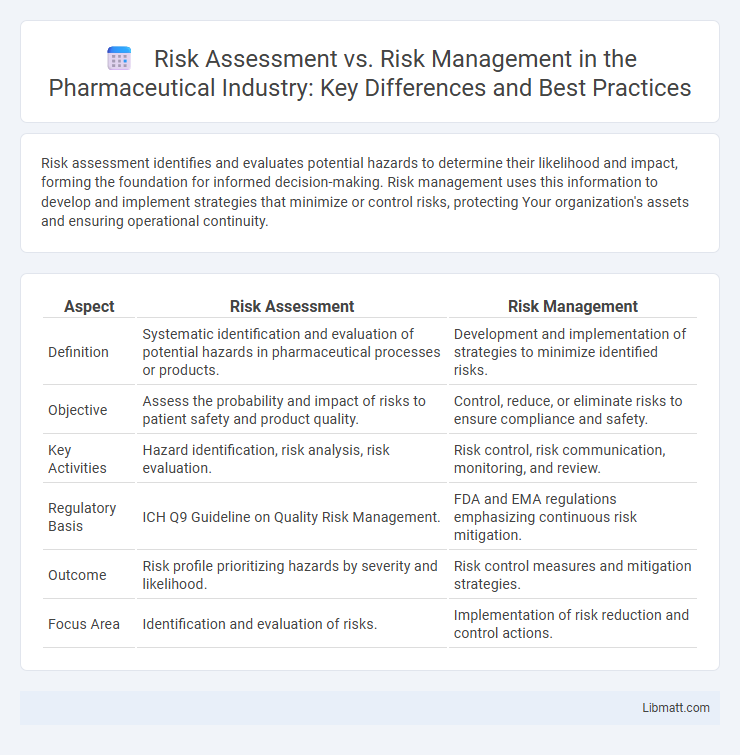Risk assessment identifies and evaluates potential hazards to determine their likelihood and impact, forming the foundation for informed decision-making. Risk management uses this information to develop and implement strategies that minimize or control risks, protecting Your organization's assets and ensuring operational continuity.
Table of Comparison
| Aspect | Risk Assessment | Risk Management |
|---|---|---|
| Definition | Systematic identification and evaluation of potential hazards in pharmaceutical processes or products. | Development and implementation of strategies to minimize identified risks. |
| Objective | Assess the probability and impact of risks to patient safety and product quality. | Control, reduce, or eliminate risks to ensure compliance and safety. |
| Key Activities | Hazard identification, risk analysis, risk evaluation. | Risk control, risk communication, monitoring, and review. |
| Regulatory Basis | ICH Q9 Guideline on Quality Risk Management. | FDA and EMA regulations emphasizing continuous risk mitigation. |
| Outcome | Risk profile prioritizing hazards by severity and likelihood. | Risk control measures and mitigation strategies. |
| Focus Area | Identification and evaluation of risks. | Implementation of risk reduction and control actions. |
Understanding Risk Assessment
Risk assessment involves systematically identifying, analyzing, and evaluating potential hazards that could impact your organization or project, forming the foundation for informed decision-making. This process quantifies the likelihood and potential consequences of risks, enabling prioritization based on severity and probability. Understanding risk assessment is essential for developing effective strategies to mitigate threats and protect valuable assets.
Key Components of Risk Management
Risk management encompasses key components such as risk identification, risk analysis, risk evaluation, risk treatment, and continuous monitoring. These steps work together to reduce potential threats and maximize opportunities by implementing strategies tailored to your organization's risk profile. Effective risk management ensures that identified risks are systematically addressed and controlled throughout the project or business lifecycle.
Differences Between Risk Assessment and Risk Management
Risk assessment involves identifying and evaluating potential hazards and their impact, quantifying the likelihood and severity of risks. Risk management extends beyond assessment by implementing strategies and controls to mitigate, monitor, and review those risks continuously. The primary difference lies in risk assessment being a diagnostic process, while risk management represents the comprehensive application of policies and actions to minimize risk exposure.
Importance of Risk Assessment in Organizations
Risk assessment is crucial in organizations as it identifies potential hazards and evaluates their impact, allowing for informed decision-making and prioritization of resources. Effective risk assessment provides data-driven insights that form the foundation of risk management strategies, ensuring proactive measures to mitigate threats. Organizations that invest in comprehensive risk assessment enhance safety, compliance, and operational resilience.
Steps Involved in Risk Assessment
Risk assessment involves identifying hazards, analyzing and evaluating the associated risks, and determining the potential impact on your organization or project. Key steps include hazard identification, risk analysis, risk evaluation, and reporting findings to prioritize risk mitigation efforts. This structured process lays the foundation for effective risk management strategies that protect assets and ensure safety.
Essential Elements of Effective Risk Management
Effective risk management involves identifying, analyzing, and prioritizing risks to minimize their impact on your organization's objectives. Essential elements include risk identification, risk assessment, risk control strategies, and continuous monitoring to ensure timely response to emerging threats. Integrating clear communication and stakeholder involvement further strengthens the risk management process, ensuring comprehensive protection and resilience.
Integrating Risk Assessment and Risk Management Processes
Integrating risk assessment and risk management processes enhances organizational resilience by systematically identifying, analyzing, and prioritizing risks before developing effective mitigation strategies. This integration promotes continuous monitoring and dynamic response adjustments based on real-time risk data and assessment outcomes. Effective collaboration between risk assessment and management teams supports comprehensive decision-making and optimizes resource allocation for risk reduction.
Common Challenges in Risk Assessment and Management
Common challenges in risk assessment and management include accurately identifying and prioritizing risks due to incomplete data or evolving threat landscapes. Organizations often struggle with integrating risk assessment findings into strategic decision-making and maintaining effective communication across departments. Ensuring continuous monitoring and adapting risk management frameworks to dynamic operational environments also presents significant obstacles.
Best Practices for Risk Assessment and Management
Effective risk assessment involves identifying, analyzing, and prioritizing potential risks using qualitative and quantitative methods to ensure accurate evaluation. Best practices for risk management include developing risk mitigation strategies, continuous monitoring, and integrating risk response plans into organizational processes to minimize impact. Employing frameworks such as ISO 31000 and regularly updating risk registers enhances decision-making and resilience.
Future Trends in Risk Assessment and Risk Management
Future trends in risk assessment emphasize the integration of artificial intelligence and machine learning to enhance predictive accuracy and real-time data analysis. Risk management is evolving with increased automation, advanced analytics, and a stronger focus on cybersecurity to proactively mitigate emerging threats. Your organization can leverage these innovations to improve decision-making and resilience against complex, dynamic risks.
Risk assessment vs Risk management Infographic

 libmatt.com
libmatt.com